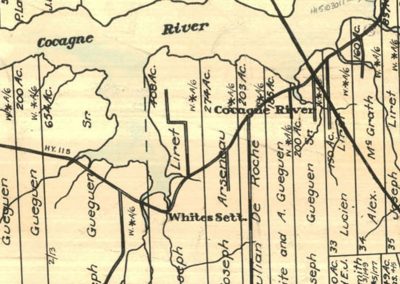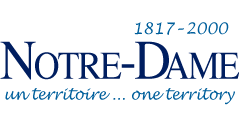Whites Settlement
The historical village of Whites Settlement is located along Whites Settlement Road which stretches between MacDougall Settlement Road and the South side of the Cocagne River Road. It also traditionally included a few houses located westward on the South side road where several LeBlanc families were settled and continue to live today, thus the name Whites Settlement. Its most famous resident was artist Léo LeBlanc, renown painter of folk art and holder of many awards.
Abt 1880
The first settlers at the edge of Whites Settlement are believed to have been residents of Dundas Village and Gladeside. They included William Crawford, Henry West, Samuel Webb, Thomas Teed, Joseph Riley, George Hope, and the Colborne families. These names are familiar to the Union Church community. They came to Notre-Dame when it was known that the Moncton-Bouctouche rail line would pass through this area.
Note: Gladeside is located app 2 km SE of Trafalgar and Dundas Village, NB. It was first called McLaughlin Road with a post office operating between 1861 and 1929. In 1866, it was a farming settlement with 24 families; in 1871, it had a population of 200; in 1898 it had 1 sawmill, 1 church and a population of 250. It was renamed Gladeside in 1929 with Gladeside Post Office operating until 1932.
Abt 1880
Two schools were built: a French-speaking school in LeBlancville which remained open until 1946 and an English-speaking school in MacDougall Settlement which remained open until 1958.
1887
A school inspector reports that John Leger teaches 38 students from grades one to eight at the Whites Settlement School. Magloire Cormier is the school secretary. In 1904, this school remained part of District 11, Dundas and Wellington. At one point, schoolteacher Henry Bourgeois had 42 students including Léo B. LeBlanc who became a famous painter.
1893
In July, Guilford P. Goguen paid Joachim P. Goguen $1.20 for 2 lbs of tobacco according to a worker’s diary.
1893
Work records indicate that Charles Noël, Maxime Gallant, David Chapman and Philip A. Goguen worked on the bridge over the Cocagne River at Notre-Dame.
1894
On May 30, 1894, Philip Goguen exchanged $4.25 worth of potatoes and bought two sheep from Maximin Babineau for $2.50 as noted in a record of household affairs.
1895
On June 10, 1895, Maximin Babineau bought one pair of oxen for $40 as noted in a record of household affairs.
1896
In June 1896, Edward White hired several men to work: Fred Barnes, Thomas Scott, John Cochran, Silvain Goguen, Maxime Goguen, and Philip A. Goguen.
1897
On October 9, 1897, Ferdinand Léger bought 12m of shingles for $12 as noted in a record of household affairs.
1897
A post office opened in Whites Settlement and remained in operation until 1912.
1900
One-half ton of hay cost $3.50, one bushel grass seed $2.50, one pair of shoes $1.10, five locks and nobs $1.50, one bottle of Mother Seigel $0.30, one hundred lbs of flour $5, three lbs of tea $1.20, one gallon of oil $0.25, and one bottle of liniment $0.35 according to a record of household affairs.
1901
The Catholic Church was officially named Notre-Dame-du-Sacré-Coeur and the parish subsequently defined the territory of the community of Notre-Dame. The settlements (or historical villages) included were MacDougall Settlement, Poirier Office, LeBlancville, Dufourville, Notre-Dame Centre, Guéguen, Hays, Alexandrina-Nor’ouest, North and South sides of the river, Whites Settlement along with Village des Pishcots, Village des Fricots, Suretteville, Teed Road and Chemin des Thaddées.
1904
Whites Settlement was described as a farming community with one post office and a population of 100. It was named for several LeBlanc families who were early settlers.
1918
Léo B. LeBlanc was four years old when his family left Moncton to settle on a farm along South Cocagne River Road South, at Whites Settlement. In 1972, at the age of fifty-three, he began painting, and in a short time his works became famous, valuable and in demand. In 1984, he won the prestigious “National Artists’ Book Competition of Canada” for his book entitled In the Land of Plenty. He died on May 14, 1986, having produced more than 300 paintings.
1924-25
Honoré (Henry) Bourgeois was a teacher at the Whites Settlement School, and he had forty-two students in grades one to eight. One of them was Léo B. LeBlanc, who late in life, would become a famous artist. The school would be replaced in 1949.
1949-50
The first Whites Settlement school was replaced with the building of a new school. It was under the purview of Notre-Dame and remained open for about 15 years. With changes in school districts, students at Whites Settlement school were transferred to Cocagne.
2000
In March, the postal addresses were changed from site and box number to civic numbers thereby improving efficiently and visibility, especially for emergency services such as fire and balance services.


